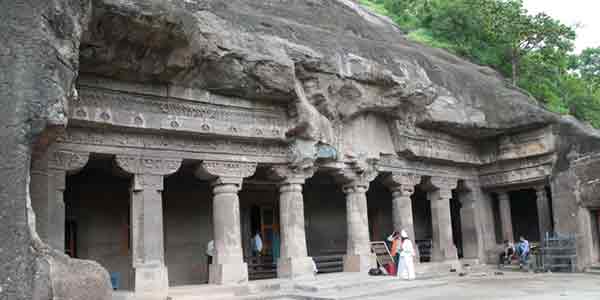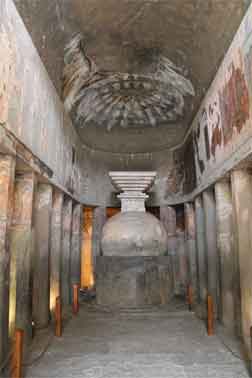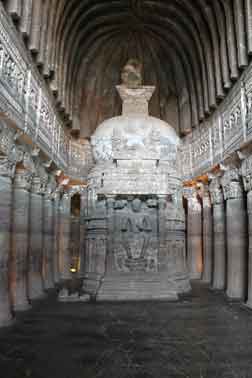Ajanta Caves are a set of ancient rock-cut caves located in the Aurangabad district of Maharashtra, India. These caves are famous for their stunning paintings, sculptures, and architecture, and are considered to be one of the greatest surviving examples of ancient Indian art. The Ajanta Caves were constructed between the 2nd century BCE and the 6th century CE, during the reigns of various Indian dynasties such as the Satavahanas, the Vakatakas, the Guptas, and the Chalukyas. The caves were primarily used as Buddhist monasteries and prayer halls, and are believed to have been abandoned in the 7th century CE due to the decline of Buddhism in India.

Political Background:
The political background of the Ajanta Caves is intertwined with the history of ancient India. During the time when the caves were constructed, India was ruled by various dynasties, each of which contributed to the rich cultural and artistic heritage of the country.
The Satavahanas were the first dynasty to rule over the region where the Ajanta Caves are located. They were followed by the Vakatakas, who were great patrons of art and architecture. The Vakataka king, Harishena, is credited with commissioning some of the most elaborate caves at Ajanta, including Cave 16, which is known for its exquisite paintings.
The Gupta dynasty, which ruled over India during the 4th and 5th centuries CE, is also believed to have contributed to the construction of some of the Ajanta Caves. The Guptas were known for their support of the arts and their patronage of Buddhist monasteries.
The Chalukya dynasty, which ruled over the region in the 6th century CE, is believed to have played a significant role in the decline of Buddhism in India. This decline led to the abandonment of the Ajanta Caves, which were left to decay for centuries until they were rediscovered in the 19th century by British archaeologists
Important Caves in Ajanta
Caves 9, 10, 19, 26, and 29 at Ajanta are among the most significant and well-preserved caves in the Ajanta Caves complex. These caves have great importance for their architecture, sculptures, and paintings, which reflect the evolution of ancient Indian art and architecture.

Cave 9: This cave is one of the earliest caves at Ajanta and is believed to date back to the 2nd century BCE. It is a chaitya (prayer hall) cave, and its significance lies in its early architectural features. The cave has a horseshoe-shaped entrance, a vaulted ceiling, and a stupa (a Buddhist monument) at its center. The stupa is carved with intricate sculptures, and the walls of the cave are adorned with paintings of Buddha and other Buddhist figures.
Cave 10: This cave is another chaitya cave at Ajanta and is similar in design to Cave 9. However, its significance lies in its sculptures, which are among the finest at Ajanta. The sculptures depict various Buddhist figures, including Buddha, and are carved with great detail and precision.
Cave 19: This cave is a monastery cave, and its significance lies in its architecture and sculptures. The cave has a large hall with several small cells around its periphery, which were used by Buddhist monks as living quarters. The walls of the cave are adorned with paintings of Buddha and other Buddhist figures, which are among the most well-preserved at Ajanta.
Cave 26: This cave is also a monastery cave and is significant for its architecture and paintings. The cave has a large hall with several small cells, and its walls are adorned with intricate paintings depicting scenes from the Jataka tales (stories of the Buddha’s previous lives). The paintings are among the most elaborate and well-preserved at Ajanta and are a testament to the artistic skills of ancient Indian artists.


Cave 26: This cave is also a monastery cave and is significant for its architecture and paintings. The cave has a large hall with several small cells, and its walls are adorned with intricate paintings depicting scenes from the Jataka tales (stories of the Buddha’s previous lives). The paintings are among the most elaborate and well-preserved at Ajanta and are a testament to the artistic skills of ancient Indian artists.
Cave 29: This cave is a chaitya cave, and its significance lies in its architectural features. The cave has a horseshoe-shaped entrance and a large stupa at its center. The stupa is carved with intricate sculptures, and the walls of the cave are adorned with paintings of Buddha and other Buddhist figures.
Conclusion:
In conclusion, Caves 9, 10, 19, 26, and 29 are of great importance for their architectural features, sculptures, and paintings, which reflect the evolution of ancient Indian art and architecture. These caves provide valuable insights into the cultural and artistic heritage of ancient India and are a must-see for art history enthusiasts and visitors to the Ajanta Caves complex.


